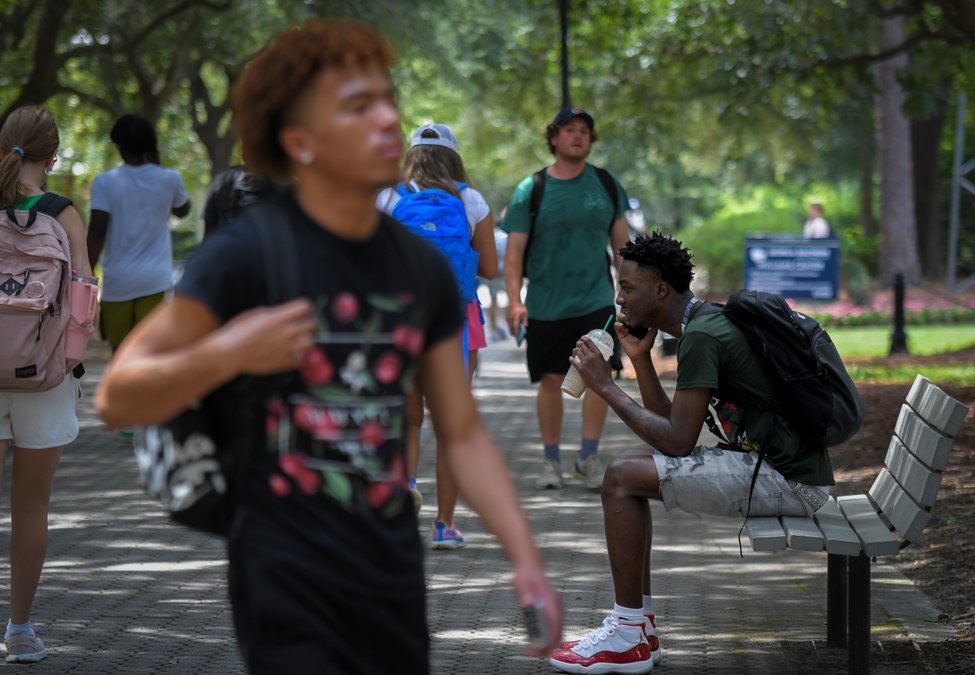By Al Hackle, Statesboro Herald.
As fall semester classes began Monday, Georgia Southern’s enrollment was on the increase, the university’s vice president for enrollment management, Dr. Amy Ballagh, said. Early estimates point to a partial recovery of 2% or more after the more than 5% drop in enrollment Georgia Southern experienced last year, when most University System of Georgia institutions saw declines.
University officials never know the final fall enrollment during the first week of classes.
“You know I have to laugh when people ask what the enrollment’s going to look like on the first day of class, because it’s going to change quite a bit over the next month and a half. … It’s a little bit of an up and down,” Ballagh said.
The official count is taken in mid-October after withdrawal deadlines have passed, along with the lingering uncertainty caused by no-shows and late-enrolling students. But Ballagh has been looking at the upward- trending numbers every day for about six months.
“Looking at where we are right now, we are around 26,000 students,” she said. “We’ll land somewhere around that number.”
Since Georgia Southern’s fall semester 2022 census was 25,506 students, an additional 500 students would be approximately a 2% increase. But last fall’s total had reflected a 5.9% decrease from fall 2021, when the university had 27,091 students enrolled at the official October count.
These numbers include undergraduate and graduate students enrolled at Georgia Southern’s Statesboro, Armstrong (Savannah) and Liberty (Hinesville) campuses, and “Online Campus” students who take internet- based classes exclusively.
Last year’s drop
Enrollment overall at the 26 University System of Georgia institutions fell 1.8% from fall semester 2021 to fall 2022, according to the USG’s report released last November. While enrollment grew by 1.2% at the top research universities — Georgia Tech, the University of Georgia, Georgia State University and Augusta University — it declined in the system’s three other categories of schools. Comprehensive universities — the category the state places Georgia Southern in along with Kennesaw State, the University of West Georgia and Valdosta State — saw a 3.7% enrollment decline as a group, while smaller “state” universities were down 5.7% and state colleges dropped 2.4%.
Enrollment officers have identified two major factors in that decline, both rooted in the COVID-19 pandemic, Ballagh observed. The first was the lateness of the University System of Georgia’s decision to wave requirements for scores from admissions tests, such as the SAT and ACT, after four of the five neighboring states — Alabama, North Carolina, South Carolina and Tennessee — had chosen to make test scores optional. Florida still required the scores, and Tennessee has now returned to requiring them.
“We found that our freshman classes were smaller last year,” Ballagh said. “We actually had a lot of students that graduated from Georgia high schools that chose to go out of state, and that was related to admission requirements that were not yet in place for USG institutions.”
The USG Board of Regents did ultimately make test scores optional for fall 2022 admissions to most of its schools when students met certain requirements for high school grades. But this was first announced in March 2022, which Ballagh notes was “pretty late in the enrollment and recruitment cycle” for first-year students.
“So we started seeing that a lot of students had already made choices to go elsewhere based on the fact that they did not have test scores, had not taken the test, and so they couldn’t even meet our admission requirements,” she said.
The Board of Regents remedied this for fall 2023, extending the test scores waiver last fall, one year in advance. Students with a high school grade point average of 3.2 — calculated by the University System’s rules — can gain admission to Georgia Southern and the other three “comprehensive” universities without submitting test scores.
The GPAs required for the waiver are higher, 3.4, for Augusta University and Georgia State University, and lower, 3.0, for the smaller “state” universities. These waivers have now been extended through the 2024-25 academic year. Georgia Tech, the University of Georgia and Georgia College & State University still require test scores.
“We think the fact that we have been test-optional for the entire recruitment cycle has helped, so we are actually seeing more students stay in Georgia. That was one of (University System Chancellor Sonny Perdue’s) goals this year,” Ballagh said.
Another thing helping this year, she said, is that the Legislature and Gov. Brian Kemp in their budget funded HOPE scholarships to cover 100% of tuition at University System schools. The scholarships previously covered about 90% of tuition for students with a GPA of 3.0 or better. They still don’t cover fees and other college costs, but the lottery-funded scholarships eliminate tuition for many students.
Another factor
Another factor in the generalized 2023 enrollment decline, one that affected schools in other states as well, was an increase in the number of high school students deciding not to go to college during or after the pandemic.
“We’ve increasingly seen more students choosing not to enroll in the university after they graduate from high school,” Ballagh said. “Some of them have gone to work directly from high school at larger percentages.”
But this fall, by her estimates, Georgia Southern is on track to have approximately 4,600 freshmen, across all campuses, up from 4,260 firstyear students last fall.

